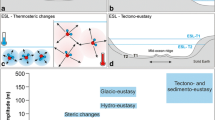Abstract
Numerical model simulations of sea-breeze circulations under idealized conditions are subjected to dimensional analyses in order to resolve sea-breeze dynamical relations and unify previous results based on observations. The analysis is motivated by the fact that sea-breeze depth scaling and volume flux scaling are only partially understood. The analysis is based on nonlinear numerical modelling simulations in combination with recent observational scaling analyses. The analysis confirms scaling laws for sea-breeze strength dependence on governing variables and shows how the sea-breeze speed scale is controlled by surface heat flux. It also shows that the sea-breeze depth scale is controlled by stability. By combining sea-breeze speed and depth scales, the sea-breeze volume flux scale is determined by an equilibrium between the accumulated convergence of heat over land since sunrise and stable air advection from the sea surface.
Similar content being viewed by others
References
Arritt R (1987) The effect of water surface temperature on lake breezes and thermal internal boundary layers. Boundary-Layer Meteorol 40:101–125
Arritt R (1989) Numerical modelling on the offshore extent of sea breezes. Quart J Roy Meteorol Soc 115:547–570
Bougeault P, Lacarrère P (1989) Parameterization of orography-induced turbulence in a Mesobeta-Scale model. Mon Wea Rev 117:1872–1890
Clappier A, Perrochet P, Martilli A, Muller F, Krueger BC (1996) A new non-hydrostatic mesoscale model using a control volume finite element (CVFE) discretisation technique. In: PM Borrell et al. (eds) Proceedings of EUROTRAC symposium 96. Computational Mechanics Publications, Southampton, U.K., pp. 527–531
Deardoff J (1978) Efficient prediction of ground surface temperature and moisture, with inclusion of a layer of vegetation. J Geophys Res 83:1198–1903
Finkele K, Hacker JM, Kraus H, Byronscott R (1995) A complete sea-breeze circulation cell-derived from aircraft observations. Boundary-Layer Meteorol 73(3):299–317
Martilli A (2003) A two-dimensional numerical study of the impact of a city on atmospheric circulation and pollutant dispersion in a coastal environment. Boundary-Layer Meteorol 108:91–119
Pielke RA, Segal M (1986) Mesoscale circulations forced by differential terrain heating. In: PS Ray (ed) Mesoscale meteorology and forecasting. Amer Meteorol Soc, Boston, 793 pp, chapter 22, pp. 516–548
Porson A (2005) Sea breeze Scaling in idealized conditions: the influence of topography and large-Scale winds. Ph.D Dissertation, Université catholique de Louvain, Louvain-la-Neuve, Belgium, 259 pp
Raymond WH, Garder A (1988) A spatial filter for use in finite area calculations. Mon Wea Rev 116:209–222
Schayes G, Thunis P, Bornstein R (1996) Topographic vorticity-mode mesoscale-beta (TVM) model. Part I: formulation. J Appl Meteorol 35:1818–1823
Simpson JE (1969) A comparison between laboratory and atmospheric density currents. Quart J Roy Meteorol Soc 95:758–765
Steyn DG (1998) Scaling the vertical structure of sea breezes. Boundary-Layer Meteorol 86:505–524
Steyn DG (2003) Scaling the vertical structure of sea breezes revisited. Boundary-Layer Meteorol 107:177–188
Stull RB (1988) An introduction to boundary layer meteorology. Kluwer Academic Publishers, Dordrecht, The Netherlands, 666 pp
Therry G, Lacarrère P (1983) Improving the Eddy kinetic energy model for planetary boundary layer description. Boundary-Layer Meteorol 25:63–88
Thunis P, Clappier A (2000) Formulation and evaluation of a Non-Hydrostatic meoscale vorticity model (TVM). Mon Wea Rev 128:3236–3250
Tijm ABC, van Delden AJ, Holtslag AAM (1999a) The inland penetration of sea breezes. Contr Atmos Phys 72(4):317–328
Tijm ABC, Holtslag AAM, van Delden AJ (1999b) Observations and modeling of the sea breeze with the return current. Mon Wea Rev 127:625–640
Walsh JE (1974) Sea breeze theory and applications. J Atmos Sci 31:2012–2026
Wichink Kruit RJ, Holtslag AAM, Tijm ABC (2004) Scaling of the sea-breeze strength with observations in the Netherlands. Boundary-Layer Meteorol 112:369–380
Author information
Authors and Affiliations
Corresponding author
Rights and permissions
About this article
Cite this article
Porson, A., Steyn, D.G. & Schayes, G. Sea-breeze scaling from numerical model simulations, Part I: Pure sea breezes. Boundary-Layer Meteorol 122, 17–29 (2007). https://doi.org/10.1007/s10546-006-9090-4
Received:
Accepted:
Published:
Issue Date:
DOI: https://doi.org/10.1007/s10546-006-9090-4




